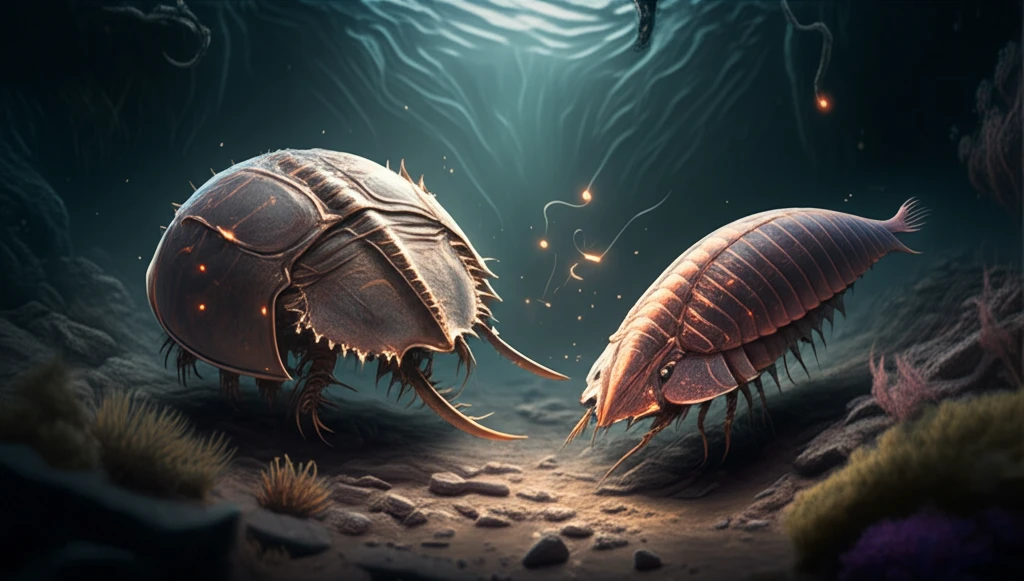
Crushing It Through Time: How Ancient Arthropods Mastered Shell-Crushing Like Modern Horseshoe Crabs
"New research reveals surprising similarities in the shell-crushing abilities of ancient arthropods and modern horseshoe crabs, shedding light on the evolution of predatory techniques and the Cambrian "arms race.""
Modern predatory arthropods exhibit a remarkable diversity of feeding strategies and specialized structures for capturing and consuming prey. Among the earliest examples of these adaptations are gnathobases, tooth-like projections found on the appendages of fossil arthropods. These structures suggest that even the earliest arthropods were equipped for complex feeding behaviors, but only one extant group still rocks these unique sets of 'teeth': horseshoe crabs. Their unique chewing method makes them interesting study subjects.
Limulus polyphemus, the American horseshoe crab, stands out as a living relic with gnathobases on its walking appendages. While its modern biology is well-understood, including its fondness for crushing shells, the feeding mechanics of this species have remained largely a mystery. Intriguingly, L. polyphemus is often considered an analogue of extinct arthropods with similar gnathobases, such as eurypterids and Cambrian species like Sidneyia inexpectans. But until now, no one has ever done a side-by-side comparison.
Now, researchers have applied advanced computational techniques to model the feeding mechanics of both L. polyphemus and S. inexpectans. By using 3D finite-element analysis (FEA), scientists were able to compare the shell-crushing capabilities of these creatures, separated by over 500 million years of evolution. The results offer insights into the feeding ecology of Cambrian arthropods and the early evolution of predatory behaviors.
Decoding the Ancient Bite: How the Study Was Conducted

To compare the feeding mechanics of Limulus polyphemus and Sidneyia inexpectans, researchers created detailed 3D models of their feeding appendages and applied finite element analysis (FEA). FEA is a computational method used to predict how a structure will respond to various forces and stresses. In this case, it allowed the scientists to simulate the act of shell-crushing and observe the resulting strain and stress distributions in the arthropods' feeding structures.
- Modern Horseshoe Crab Model: A female L. polyphemus specimen was scanned using micro-CT to create a detailed 3D reconstruction of its cephalothoracic appendage set V, which includes the gnathobases used for crushing.
- Muscle Simulation: The researchers digitally dissected the muscles involved in mastication and calculated their cross-sectional area (MCSA) from the CT scans. MCSA values were then converted into maximum muscle force estimates to inform the FEA model.
- Finite Element Analysis: The 3D model of the horseshoe crab coxa (the segment bearing the gnathobases) was imported into FEA software. Material properties were assigned based on known values for sclerotized cuticle, and muscle forces were applied to simulate adduction of the coxae. The gnathobases were constrained to mimic the contact with prey during crushing.
- Validation: A live horseshoe crab was induced to process food while a force-sensitive resistor measured its bite force. This real-world data was compared to the reaction forces predicted by the FEA model to ensure the accuracy of the simulation.
- Fossil Arthropod Model: Due to the nature of fossil preservation, a 3D model of Sidneyia inexpectans was digitally reconstructed based on published images and morphological details from various specimens. The model was scaled to match the volume of the horseshoe crab coxa.
- Comparative Analysis: The same FEA parameters and constraints used for the horseshoe crab model were applied to the S. inexpectans model. Von Mises microstrain distributions were compared between the two models, and statistical tests were used to assess the similarity of strain patterns along the appendages.
A 500-Million-Year-Old Solution
This research demonstrates a remarkable functional similarity in the feeding apparatus of Sidneyia inexpectans and Limulus polyphemus, separated by vast spans of geological time. The findings suggest that shell-crushing capabilities evolved early in arthropod history, playing a role in the Cambrian explosion and the subsequent diversification of marine life. The arrival of durophagous predators likely fueled an evolutionary "arms race," driving the development of more robust shells and other defenses in prey species. By combining paleontology, biomechanics, and computational modeling, this study sheds new light on the ancient origins of ecological interactions that continue to shape our world today. Now that’s what I call interdisciplinary.
